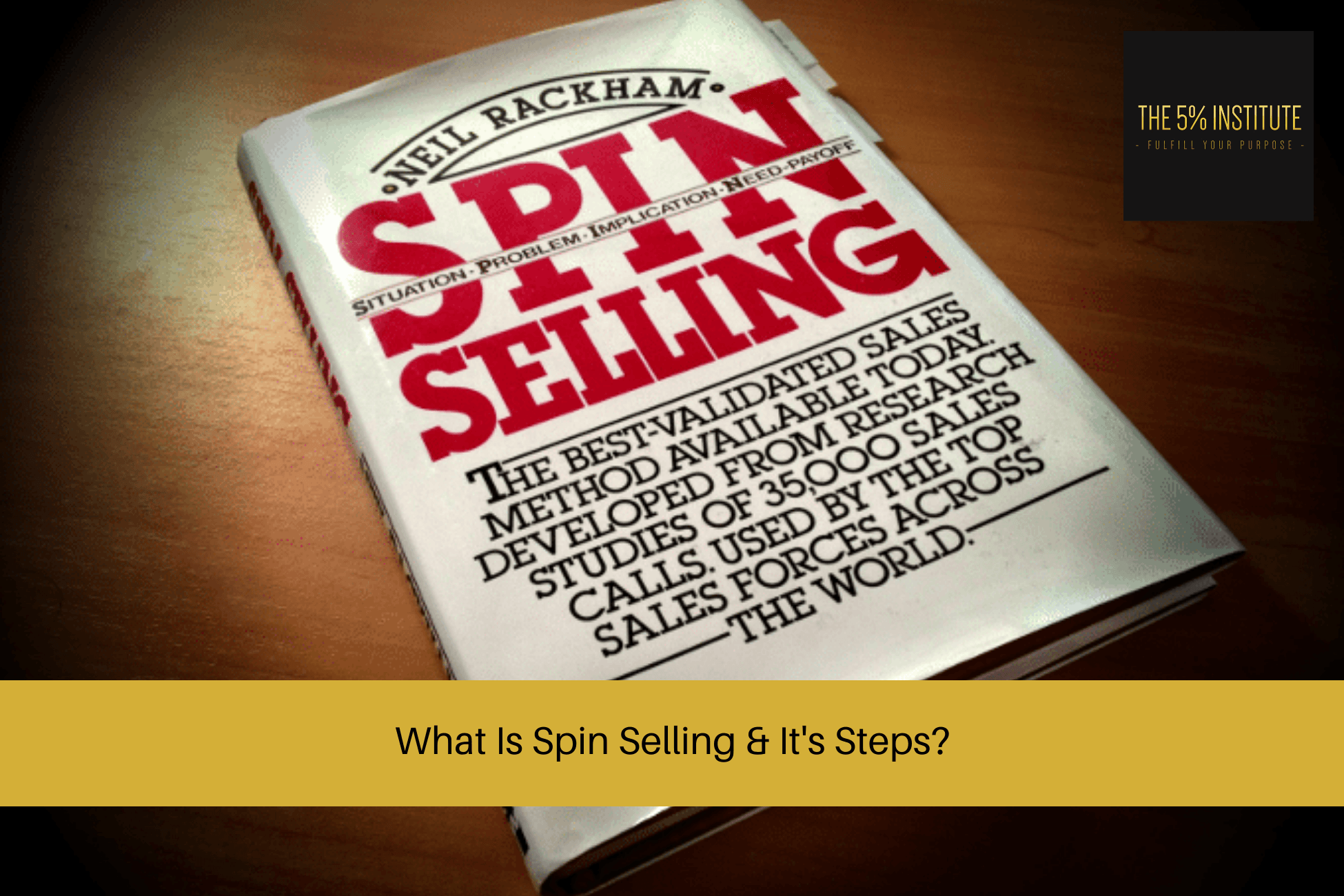
What Is Spin Selling & It’s Steps?
Spin Selling is something you may have come across from time to time, as it is a famously known acronym in the world of sales.
But what is Spin Selling; what are the steps, and is it still useful in sales today?
In this article, we’ll explore:
- What is Spin Selling?
- What are the steps of Spin Selling
- The difference between Spin Selling and The 5% Sales Blueprint
What Is Spin Selling?
Spin Selling is one of the famous sales methodologies, or sales processes that Sales Professionals and Business Owners use in their face to face sales conversations; which was designed to guide the sales conversation, using a consultative selling approach.
A step by step system is crucial for sales success, because it creates certainty for both you and your potential client, and if done effectively – positions you as a Specialist rather than another commodity.
Spin Selling was created by author Neil Rackham in the 1980’s, after reviewing many sales calls – and finding what commonalities made Sales Professionals more successful.
It’s a recommended read, and you can check out his book Spin Selling by clicking the link here.
Related article: The 5 x Top Sales Methodologies For Sales Success
What Are The Steps In Spin Selling?
Each letter in the word Spin Selling, refers to a set of questions you can ask your potential clients during that part of the process.
The acronym for Spin Selling is as per below:
- S: Situation
- P: Problem
- I: Implication
- N: Need
Situation
The S in Spin Selling stands for Situation.
Situation questions are interview type questions that help you understand what their current situation is right now, prior to taking any course of action.
By uncovering their situation, you can understand the landscape of where they’re currently at, and whether or not they actually will have a need for your product, service or solution.
Some examples of situation questions include:
- What does your process look like at the moment?
- Help me understand why we’re meeting today?
- What would you like out of our meeting today?
- Can you please share what tools you’re currently using at the moment?
- How often do you use xyz?
Problem
The second letter in the acronym Spin Selling is Problem.
Spin Selling teaches that you need to identify their problems, before you can move further from this point.
Generally, the methodology teaches that you keep this area logical and factual.
This is different to The 5% Sales Blueprint, where we want you to identify the emotion behind the problem (or pain); but more on this later.
The aim of the problem section is to ask questions that identify the person’s pain points with their current situation.
Some examples of problem questions include:
- How is this currently costing you money-wise?
- If you can, can you let me know how much time this is costing your staff?
- What other contributing issues are caused by this problem?
- How long has this been an issue for you?
- What have you done in this past to fix this issue?
Implication
The third letter in Spin Selling is I – standing for Implication.
The aim of the implication section is to have the potential client see what will happen if they don’t take any action in fixing their current situation, and problems.
By them answering that they will have more problems, will drive them to want to find a solution to their problems.
Examples of implication questions include:
- If you’re unable to find a solution to your issue, what do you think will happen next?
- Thanks for mentioning those issues; what happens if you’re unable to fix these issues?
- If it’s been causing these kinds of issues for these many years – how much will it cost if you continue letting the issues carry on?
- How much time will be wasted of you don’t fix the issue?
Need
The forth letter in Spin Selling stands for Need.
Need; or also referred to need-payoff, is asking questions that’ll open the opportunity for your presentation of a solution.
Examples of need type questions are:
- If you’re able to fix these issues, how much will you save per month?
- Can you kindly elaborate how much time will be saved if you fix these issues?
- Pretend you’re able to fix these issues – what would you day look like with these issues gone?
- If we’re able to solve these problems for you, do you think your team will find it valuable?
The Difference Between Spin Selling & The 5% Sales Blueprint
Spin Selling by Neil Rackham is a fantastic resource for Sales Professionals to help guide you through the type of consultative questions to ask in each section of the sales process.
However we believe they are just that – question frameworks.
The 5% Sales Blueprint is a bigger sales methodology, yet also focuses on using a system – or consistent framework to help you win the sale.
It helps you achieve this, by giving you a step by step process on what to do during your entire sales dialogue – rather than just the questioning aspect.
Studies find that people generally make purchases based on emotion, and justify it with logic.
The 5% Sales Blueprint has been crafted and designed to help guide your potential client on a journey; so by asking the right questions and following the right steps, you can help them sell themselves.
By helping them sell themselves, the sale has less friction, and your sales closing rate will increase.
So Spin Selling focuses on four key areas, where The 5% Sales Blueprint focuses on the entire dialogue.
Steps In The 5% Sales Blueprint
The 5% Sales Blueprint consists of the following steps:
- Rapport
- Setting pre-frames – countering objections upfront
- Sales questions (this area is similar to Spin Selling)
- Iceberg selling – getting deep emotionally
- Discovering pain
- Uncovering desire
- Implications of money, and budget to solve their issues
- Presenting
- Asking for the sale
- Handling objections
The 5% Sales Blueprint is also process and structure driven, which helps Sales Professionals stay in control, and position themselves as Specialists rather than order takers.
You can learn more about each of the steps mentioned above in greater detail, by clicking on the related article below.
Related article: The Sales Process – A Step By Step Guide
Final Thoughts About Spin Selling
Spin Selling by Neil Rackham is a great book, and one you should definitely read (you can check out the book here).
Is offers a great framework to help guide you on what questions to ask, at what stage.
If you wish however to learn the framework for the entire sales conversation and not just the question aspect, we recommend you learning more about The 5% Sales Blueprint by clicking here.



